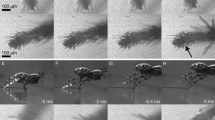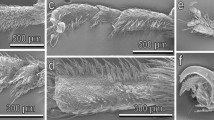Abstract
We measured ground reaction forces in fore–aft and normal directions of single hind and front legs in vertically ascending Sagra femorata beetles (Coleoptera, Chrysomelidae) on a smooth and a rough substrate. Simultaneously, we performed electromyographic recordings (EMGs) of the hind leg claw retractor muscle that partly controls the attachment structures. On both substrates, hind legs produced upward- as well as downward-directed forces during one stance phase. Forces were equivalent in both directions. Front legs generated only upward-directed forces. The main function of hind legs in ascending beetles in the second half of the stance thus probably prevented the animals from tilting away from the substrate. The EMGs of hind legs showed an early spike during stance with large amplitude. It was mostly followed by few additional spikes with large amplitude and in some cases of spikes with smaller amplitude distributed throughout the stance phase. We found significantly more spikes on the rough substrate than on the smooth one. This is probably due to the more important role of pretarsal claws than tarsal hairy attachment pads on the rough substrate or to the reduced adhesive forces on the rough substrate that have to be compensated by additional muscle activity.










Similar content being viewed by others
References
Arnold JW (1974) Adaptive features on the tarsi of cockroaches (Insecta: Dictyoptera). Int J Insect Morphol Embryol 3:317–334
Arzt E, Gorb S, Spolenak R (2003) From micro to nano contacts in biological attachment devices. Proc Natl Acad Sci 100:10603–10606
Autumn K, Peattie AM (2002) Mechanisms of adhesion in geckos. Integr Comp Biol 42:1081–1090
Autumn K, Hsieh ST, Dudek DM, Chen J, Chitaphan C, Full RJ (2006) Dynamics of geckos running vertically. J Exp Biol 209:260–272
Bauchhenß E (1979) Die Pulvillen von Calliphora erythrocephala (Diptera, Brachycera) als Adhäsionsorgane. Zoomorphologie 93:99–123
Beutel RG, Gorb SN (2001) Ultrastructure of attachment specializations of hexapods (Arthropoda): evolutionary patterns inferred from a revised ordinal phylogeny. J Zool Syst Evol Res 39:177–207
Brunn DE, Dean J (1994) Intersegmental and local interneurons in the metathorax of the stick insect Carausius morosus that monitor middle leg position. J Neurophysiol 72:1208–1219
Bullock JMR, Federle W (2009) Division of labour and sex differences between fibrillar, tarsal adhesive pads in beetles: effective elastic modulus and attachment performance. J Exp Biol 212:1876–1888
Bullock JMR, Federle W (2011) The effect of surface roughness on claw and adhesive hair performance in the dock beetle Gastrophysa viridula. Insect Sci 18:298–304
Bullock JMR, Drechseler P, Federle W (2008) Comparison of smooth and hairy attachment pads in insects: friction, adhesion and mechanisms for direction-dependence. J Exp Biol 211:3333–3343
Bußhardt P, Gorb SN (2013) Walking on smooth and rough ground: activity and timing of the claw retractor muscle in the beetle Pachnoda marginata peregrina (Coleoptera, Scarabaeidae). J Exp Biol 216:319–328
Bußhardt P, Gorb SN, Wolf H (2011) Activity of the claw retractor muscle in stick insects in wall and ceiling situations. J Exp Biol 214:1676–1684
Bußhardt P, Wolf H, Gorb SN (2012) Adhesive and frictional properties of tarsal attachment pads in stick insects (Phasmatodea) with smooth and nubby euplantulae. Zoology 115:135–141
Chapman RF (1998) Legs and locomotion. In: Simpson SJ, Douglas AE (eds) The insects: structure and function, 5th edn. Cambridge University Press, Cambridge, New York, Melbourne, pp 151–152
Chung JY, Chaudhury MK (2005) Roles of discontinuities in bio-inspired adhesive pads. J R Soc Interface 2:55–61
Clemente CJ, Federle W (2008) Pushing versus pulling: division of labour between tarsal attachment pads in cockroaches. Proc R Soc Lond B 275:1329–1336
Creton C, Gorb SN (2007) Sticky feet: from animals to materials. MRS Bull 32:466–468
Cruse H (1976) The function of the legs in the free walking stick insect, Carausius morosus. J Comp Physiol A 112:235–262
Cruse H (1990) What mechanisms coordinate leg movement in walking arthropods? Trends Neurosci 13:15–21
Dai Z, Gorb SN, Schwarz U (2002) Roughness-dependent friction force of the tarsal claw system in the beetle Pachnoda marginata (Coleoptera, Scarabaeidae). J Exp Biol 205:2479–2488
Dean J, Wendler G (1983) Stick insect locomotion on a walking wheel: interleg coordination of leg position. J Exp Biol 103:75–94
Drechsler P, Federle W (2006) Biomechanics of smooth adhesive pads in insects: influence of tarsal attachment on performance. J Comp Physiol A 192:1213–1222
Duch C, Pflüger HJ (1995) Motor patterns for horizontal and upside down walking and vertical climbing in the locust. J Exp Biol 198:1963–1976
Dürr V, Schmitz J, Cruse H (2004) Behaviour-based modelling of hexapod locomotion: linking biology and technical application. Arthropod Struct Dev 33:237–250
Federle W (2006) Why are so many adhesive pads hairy? J Exp Biol 209:2611–2621
Federle W, Brainerd EL, McMahon TA, Hölldobler B (2001) Biomechanics of the movable pretarsal adhesive organ in ants and bees. Proc Nat Acad Sci USA 98:6215–6220
Filippov A, Popov VL, Gorb SN (2011) Shear induced adhesion: contact mechanics of biological spatula-like attachment devices. J Theor Biol 276:126–131
Frantsevich L, Gorb S (2004) Structure and mechanics of the tarsal chain in the hornet, Vespa crabro (Hymenoptera: Vespidae): implications on the attachment mechanism. Arthropod Struct Dev 33:77–89
Glassmaker NJ, Jagota A, Hui C-Y, Kim J (2004) Design of biomimetic fibrillar interfaces: 1. Making contact. J R Soc Interface 1:23–33
Godden DH (1972) The motor innervation of the leg musculature and motor output during thanatosis in the stick insect Carausius morosus Br. J Comp Physiol A 80:201–225
Goel SC (1972) Notes on structure of unguitractor plate in Heteroptera (Hemiptera). J Entomol 46:167–173
Goldman DI, Chen TS, Dudek DM, Full RJ (2006) Dynamics of rapid vertical climbing in cockroaches reveals a template. J Exp Biol 209:2990–3000
Gorb SN (1996) Design of insect unguitractor apparatus. J Morphol 230:219–230
Gorb SN (1998) The design of the fly adhesive pad: distal tenant setae are adapted to the delivery of an adhesive secretion. Proc R Soc Lond B 265:747–752
Gorb SN (2001) Attachment devices of insect cuticle. Kluwer Academic Publishers, Dordrecht
Gorb SN (2011) Biological fibrillar adhesives: functional principles and biomimetic applications. In: Da Silva LFM, Öchsner A, Adams RD (eds) Handbook of adhesion technology. Springer, Berlin, Heidelberg, pp 1409–1436
Homann H (1957) Haften Spinnen an einer Wasserhaut? Naturwissenschaften 44:318–319
Hui C-Y, Glassmaker NJ, Tang T, Jagota A (2004) Design of biomimetic fibrillar interfaces: 2. Mechanics of enhanced adhesion. J R Soc Interface 1:35–48
Jagota A, Bennison SJ (2002) Mechanics of adhesion through a fibrillar microstructure. Integr Comp Biol 42:1140–1145
Kendall MD (1970) The anatomy of the tarsi of Schistocerca gregaria Forskal. Cell Tissue Res 109:112–137
Langer MG, Ruppersberg JP, Gorb S (2004) Adhesion forces measured at the level of a terminal plate of the fly’s seta. Proc R Soc Lond B 271:2209–2215
Larsen GS, Frazier SF, Fish SE, Zill SN (1995) Effects of load inversion in cockroach walking. J Comp Physiol A 176:229–238
Laurent G, Hustert R (1988) Motor neuronal receptive fields delimit patterns of motor activity during locomotion of the locust. J Neurosci 8:4349–4366
Niederegger S, Gorb SN (2003) Tarsal movements in flies during leg attachment and detachment on a smooth substrate. J Insect Physiol 49:611–620
Peisker H, Michels J, Gorb SN (2013) Evidence for a material gradient in the adhesive tarsal setae of the ladybird beetle Coccinella septempunctata. Nat commun 4:1661
Perez Goodwyn P, Peressadko A, Schwarz H, Kastner V, Gorb S (2006) Material structure, stiffness, and adhesion: why attachment pads of the grasshopper (Tettigonia viridissima) adhere more strongly than those of the locust (Locusta migratoria) (Insecta: Orthoptera). J Comp Physiol A 192:1233–1243
Persson BNJ (2003) On the mechanism of adhesion in biological systems. J Chem Phys 118:7614–7621
Persson BNJ, Gorb SN (2003) The effect of surface roughness on the adhesion of elastic plates with application to biological systems. J Chem Phys 119:11437–11444
Prüm B, Seidl R, Bohn HF, Speck T (2012a) Impact of cell shape in hierarchically structured plant surfaces on the attachment of male Colorado potato beetles (Leptinotarsa decemlineata). Beilstein J Nanotechnol 3:57–64
Prüm B, Seidl R, Bohn HF, Speck T (2012b) Plant surfaces with cuticular folds are slippery for beetles. J R Soc Interface 9:127–135
Radnikow G, Bässler U (1991) Function of a muscle whose apodeme travels through a joint moved by other muscles: why the retractor unguis muscle in stick insects is tripartite and has no antagonist. J Exp Biol 157:87–99
Rosenbaum P, Wosnitza A, Büschges A, Gruhn M (2010) Activity patterns and timing of muscle activity in the forward walking and backward walking stick insect Carausius morosus. J Neurophysiol 104:1681–1695
Roth LM, Willis ER (1952) Tarsal structure and climbing ability of cockroaches. J Exp Zool 119:483–517
Russell AP (2002) Integrative functional morphology of the gekkotan adhesive system (Reptilia: Gekkota). Integr Comp Biol 42:1154–1163
Seifert P, Heinzeller T (1989) Mechanical, sensory and glandular structures in the tarsal unguitractor apparatus of Chironomus riparius (Diptera, Chironomidae). Zoomorphology 109:71–78
Snodgrass RE (1956) Anatomy of the honey bee. Comstock Publishing Associates, New York
Stein W, Büschges A, Bässler U (2006) Intersegmental transfer of sensory signals in the stick insect leg muscle control system. J Neurobiol 66:1253–1269
Stork NE (1980) Experimental analysis of adhesion of Chrysolina polita (Chrysomelidae: Coleoptera) on a variety of surfaces. J Exp Biol 88:91–107
Varenberg M, Pugno NM, Gorb SN (2010) Spatulate structures in biological fibrillar adhesion. Soft Matter 6:3269–3272
Voigt D, Schuppert JM, Dattinger S, Gorb SN (2008) Sexual dimorphism in the attachment ability of the Colorado potato beetle Leptinotarsa decemlineata (Coleoptera: Chrysomelidae) to rough substrates. J Insect Physiol 54:765–776
Voigt D, Schweikart A, Fery A, Gorb SN (2012) Leaf beetle attachment on wrinkles: isotropic friction on anisotropic surfaces. J Exp Biol 215:1975–1982
Watson JT, Ritzmann RE, Pollack AJ (2002) Control of climbing behavior in the cockroach, Blaberus discoidalis. II. Motor activities associated with joint movement. J Comp Physiol A 188:55–69
Wolff JO, Gorb SN (2012) Comparative morphology of pretarsal scopulae in eleven spider families. Arthropod Struct Dev 41:419–433
Wolff JO, Gorb SN (2013) Radial arrangement of Janus-like setae permits friction control on spiders. Sci Rep 3:1–7
Zill SN, Keller BR, Duke ER (2009) Sensory signals of unloading in one leg following stance onset in another leg: transfer of load and emergent coordination in cockroach walking. J Neurophysiol 101:2297–2304
Zill SN, Keller BR, Chaudhry S, Duke ER, Neff D, Quinn R, Flannigan C (2010) Detecting substrate engagement: responses of tarsal campaniform sensilla in cockroaches. J Comp Physiol A 196:407–420
Acknowledgments
This study was supported by the Federal Ministry of Education and Research, Germany (Project BMBF Biona 01RB0802A) to S.N.G.
Author information
Authors and Affiliations
Corresponding author
Rights and permissions
About this article
Cite this article
Bußhardt, P., Gorb, S.N. Ground reaction forces in vertically ascending beetles and corresponding activity of the claw retractor muscle on smooth and rough substrates. J Comp Physiol A 200, 385–398 (2014). https://doi.org/10.1007/s00359-014-0896-0
Received:
Revised:
Accepted:
Published:
Issue Date:
DOI: https://doi.org/10.1007/s00359-014-0896-0




